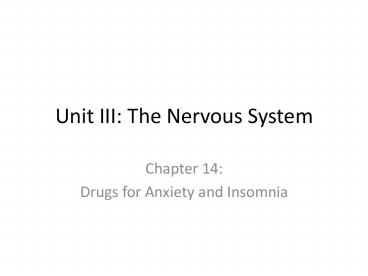Unit III: The Nervous System PowerPoint PPT Presentation
1 / 15
Title: Unit III: The Nervous System
1
Unit III The Nervous System
- Chapter 14
- Drugs for Anxiety and Insomnia
2
Definitions
- Anxiety
- a state of apprehension, tension or uneasiness
that stems from the anticipation of danger, the
source of which is largely unknown or
unrecognized. (ICD-10) - Insomnia
- a condition characterized by a clients
inability to fall asleep or remain asleep. (p.
156)
3
Categories of Anxiety
- Generalized anxiety disorder
- Panic disorder
- Phobias
- Obsessive-compulsive disorder (OCD)
- Post-traumatic stress disorder (PTSD)
4
Nonpharmacological Therapies
- Cognitive behavioral therapy
- Counseling
- Biofeedback techniques
- Meditation
5
Anxiety and Wakefulness
- Responsible brain regions
- Limbic system
- Responsible for emotional expression, learning,
and memory - Reticular activating system
6
Insomnia
- short-term (behavioral)- associated with everyday
stressors - Food or drinks containing stimulants may
interrupt sleep - Alcohol enables sleep but causes vivid dreams and
frequent awakening - long-term- associated with depression, manic
disorders, and chronic pain - Nonpharmacological measures should be tried first
- Medication-related sleep problems are most common
in the elderly
7
Anxiety and Sleep DisordersMedication
Classifications
- Antidepressants
- Tricyclic, SSRI, MAOI
- Benzodiazepines
- Barbiturates
- Nonbenzodiazepine/nonbarbiturate
8
Nursing Role in Management ofAnxiety and Sleep
Disorders
- Monitor condition and provide education
- What does this entail?
- Assess need for antianxiety or insomnia drugs
- What should this include?
- Obtain drug history
- What questions should you ask?
- Use cautiously in certain clients
- Which populations are at risk?
9
Nursing Role in Management ofAnxiety and Sleep
Disorders
- Benzodiazepine and nonbenzodiazepine
- Assess for side effects of CNS depression
- Assess neuro status, LOC
- Monitor VS, esp. respiratory pattern during sleep
- Monitor stimulant intake
- Monitor affect and emotional status
10
Antidepressants
- Primary medications to reduce anxiety and panic
- Tricyclic antidepressants (TCAs)
- Selective Serotonin Reuptake Inhibitors (SSRIs)
- Monoamine Oxydase Inhibitors (MAOIs)
- Used to treat all categories of anxiety
- escitalopram (Lexapro) prototype drug for
generalized anxiety disorder (p. 161)
11
Considerations for Antidepressants as Anxiolytics
- TCAs
- Not recommended if hx of MI, heart block or
dysrhythmia - Use cautiously in asthma, GI disorders,
alcoholism, schizophrenia or bipolar disease - SSRIs
- Safer than other classes
- Less common sympathomimetic and fewer cholinergic
effects - MAOIs
- Avoid caffeine and foods containing tyramine
- May potentiate the effects of insulin and other
diabetic drugs
12
Benzodiazepines
- Bind to GABA receptor-chloride channel molecule
- Intensify effects of GABA
- Examples
- alprazolam (Xanax)
- chlordiazepoxids (Librium)
- clorazepate (Tranxene)
- Prototype
- lorazepam (Ativan)
- p. 163
- Primary use
- Anxiety disorders and insomnia
- Adverse effects
- Drowsiness
- Dizziness
- Respiratory depression
13
Barbiturates
- Bind to GABA receptor-chloride channel molecule
- Intensifies effect of GABA
- Inhibits brain impulses from passing through
limbic system and RAS - Examples
- pentobarbital (Nembutal)
- secobarbital (Seconal)
- amobarbital (Amytal)
- Prototype
- Phenobarbital (Luminal)
- p. 176
- Primary use
- Sedative and hypnotic
- Adverse effects
- Tolerance
- Respiratory depression
- Psychological and physical dependence
14
Barbiturates
- Several barbiturates are Schedule II drugs.
What does this mean? - How often would you expect to see a barbiturate
prescribed for anxiety or insomnia? - Why?
15
Nonbenzodiazepine/Nonbarbiturates
- Bind to GABA receptors
- Preserve sleep stages III and IV
- Offer minor effects of REM sleep
- Examples
- buspirone (Buspar)
- chloral hydrate (Noctec)
- ethchlorvynol (Placidyl)
- Prototype
- zolpidem (Ambien) p. 164
- Primary use
- hypnotic
- Adverse effects
- Mild nausea, diarrhea
- Dizziness
- Confusion
- Daytime drowsiness
- Amnesia
- Sleepwalking

